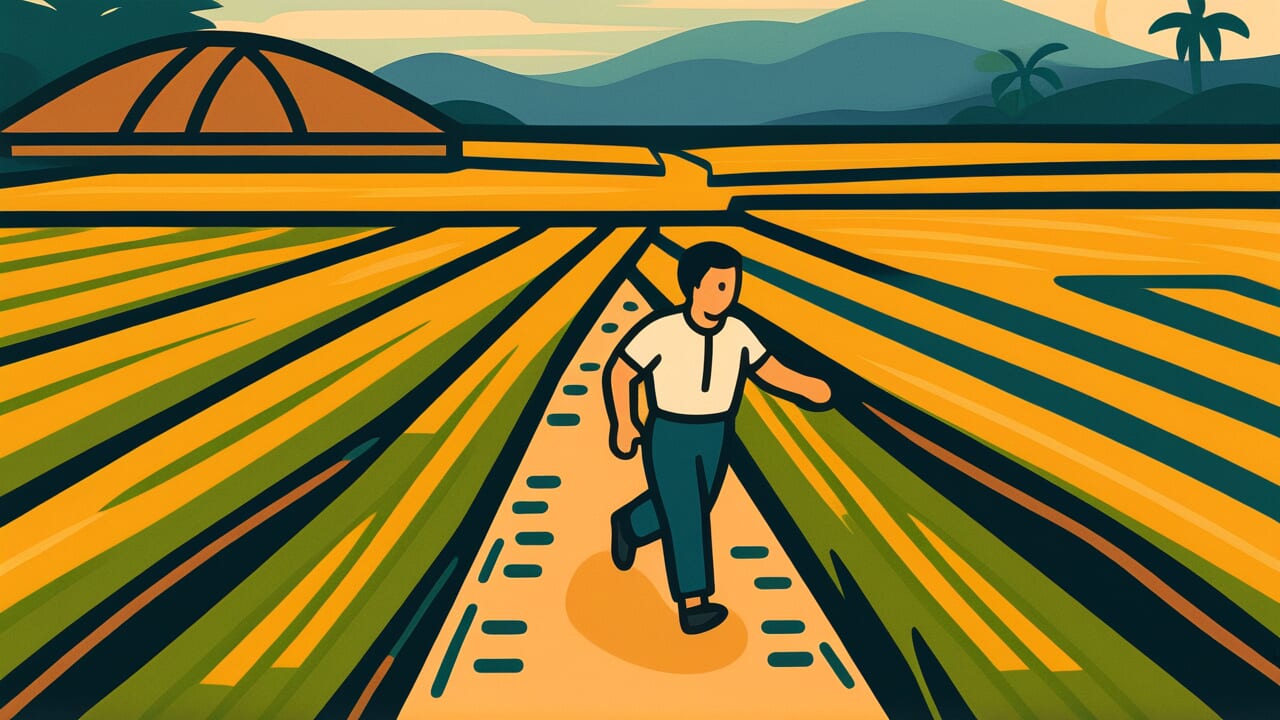How to Read “Going by the ridge or going by the rice field is the same”
Aze kara yuku mo ta kara yuku mo onaji
Meaning of “Going by the ridge or going by the rice field is the same”
This proverb means that if the destination is the same, the final result won’t change no matter which path you choose along the way.
In life, there are multiple methods and approaches to reach a certain goal. If all these methods lead to the same destination, there’s no need to worry about differences in the process.
People use this proverb when advising someone who’s struggling to choose between multiple options. It tells them to relax and decide freely since any choice leads to the same result.
It’s also used when people who took different approaches reach the same conclusion. This shows the inevitability of that outcome.
The proverb can help resolve conflicts between people arguing over different methods. It reminds them that if the goal is the same, differences in approach are trivial.
Today, it represents a flexible mindset that recognizes there’s more than one path to achieving a goal.
Origin and Etymology
The exact first appearance of this proverb in literature is unclear. However, its structure suggests it comes from everyday experiences in agricultural communities.
“Aze” refers to the narrow earthen paths between rice paddies. “Ta” means the rice field itself.
In old Japan, people moving through villages had a choice. They could walk along the ridge paths or cut across the rice fields.
Ridge paths were narrow and difficult to walk on. Sometimes they meant taking a longer route.
Walking through the rice fields could be a shortcut. But it risked trampling the rice plants or getting stuck in the mud.
This proverb likely emerged from these rural travel experiences. Each path had advantages and disadvantages.
Either way, you’d reach the same destination. So the choice didn’t really matter much.
The expression naturally arose among people doing farm work. It came from their daily experiences.
Eventually, it spread as a lesson applying to life choices in general. A concrete experience in rural landscapes transformed into universal wisdom.
Usage Examples
- Whether you go to university or get a job, if your goal is independence, going by the ridge or going by the rice field is the same
- When packing for a move, whether you start with boxes or organize by room, going by the ridge or going by the rice field is the same—you’ll move everything anyway
Universal Wisdom
This proverb has been passed down because it addresses a universal truth. Humans are creatures who struggle with choices.
Every day we face decisions large and small. We wonder which path to take. Sometimes we suffer from regret about the road not taken.
But this proverb teaches us that many of these worries aren’t actually essential.
Humans have a psychological need to believe their chosen path was the best one. That’s why we criticize others who take different approaches. We try to justify our own choices.
However, if the destination is the same, differences along the way are often just matters of personality or preference.
The wisdom this proverb offers is about letting go of attachment to process. It views results as equal.
What truly matters in life isn’t which path you chose. It’s your sense of purpose—where you’re heading.
Our ancestors understood this deep truth through everyday rural experiences. They realized something important.
Cooperating toward a common goal has far more value than fighting over different methods. This understanding is also a source of tolerance that accepts diversity.
When AI Hears This
In topology, a coffee cup and a donut are treated as the same shape. Why? Because both have one hole.
Like clay, you can continuously deform one into the other. This “property preserved through continuous deformation” is the essence of topology.
The relationship between the ridge path and the rice field path in this proverb is exactly this principle.
As routes from point A to point B, whether you walk on the ridge or through the field, mathematically they’re both “continuous curves connecting start and end points.”
Their topological properties remain unchanged. Whether the path is wide or narrow, paved or muddy—topology ignores such details.
What matters are essential structures like “Is it connected without breaks?” and “How many holes does it have?”
Interestingly, this proverb doesn’t even question “length of distance.” Even if the ridge path makes a big detour, or the field path is the shortest distance, topologically they’re equivalent.
In fact, map app route-finding algorithms work the same way. They first recognize the topologically connected road network. Then they optimize using additional information like distance and time.
In other words, all routes are initially “the same.”
This proverb may be evidence that humans intuitively understood the core of topology thousands of years ago.
Lessons for Today
Modern society overflows with choices. We face countless decisions about education, careers, and lifestyles.
We constantly wonder which is the right answer. Every time we see others’ choices on social media, we might feel anxious. Maybe our own path was wrong.
This proverb teaches us not to become too trapped by the choice itself. If your goal is clear, there’s more than one way to reach it.
Choosing a different method from others doesn’t make you inferior or wrong.
What matters is believing in the path you chose and continuing to walk it. If you have time to worry about which path to choose, use that time to move forward.
Also, when others choose different methods, you don’t need to reject them. If the destination is the same, you’ll meet there eventually.
This proverb teaches us to accept diversity, have confidence in our choices, and become free from pointless comparisons and regrets.
Your path belongs to you alone. Walk it with confidence.



Comments